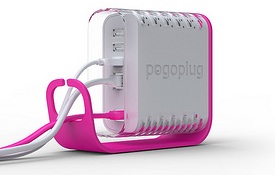Author: Joe Moran
Review Date: 4/27/2010

Price: $129
Pros: lots of USB ports, near effortless setup and media sharing, free mobile apps for most platforms
Cons: sluggish video transcoding, inconsistent streaming to game consoles
Last year, Cloud Engines introduced its PogoPlug, a petite, $99 networking device that let those with a photo-, music-, or video-laden USB storage device remotely access their material and share it with others via the Internet. At $129, the company’s newest second- generation PogoPlug sports a higher price tag than the original, but also brings improved hardware, better design aesthetics and some new features to the table.
Design and Setup
The new PogoPlug hardware has evolved from an ugly wall-wart to a slightly larger and free-standing unit that gets its juice from a thin standard shaver-style AC cord, so there’s no bulky external power supply to deal with. The new design is much better looking as well, clad as it is in a combination of white, magenta, and clear plastic. Best of all, instead of a lone USB port there are now four– one on the front, and the rest on the back where cable clutter can be kept hidden (plus there’s a handy cable loop built into the base). If the built-in USB ports aren’t enough, you can connect a USB hub to add more.
The PogoPlug gets its network connectivity from Gigabit Ethernet. Because the PogoPlug is designed primarily as a remote access and sharing device, its USB ports only support storage devices (FAT 32, NTFS, HFS+ (Mac), EXT2, and EXT3 formats). (By contrast, Iomega’s iConnect Wireless Data Station is more oriented toward local network rather than remote sharing, does support printers, and includes Wi-Fi networking as well.)
You register and activate the PogoPlug by visiting the portal Web site my.pogoplug.com, where you’ll also find videos covering the basic physical setup step by step. The videos reference and picture the older PogoPlug, but the information’s pretty much the same. Plug into power and Ethernet, and the front logo will light up green if the unit was able to establish a connection through your router (if not, some port forwarding may be necessary).
Accessing and Streaming Media
PogoPlug’s attractive browser-based UI works equally well in IE 7 and 8, Firefox, or Chrome (and is compatible with Safari too). You can browse attached drives individually, but the PogoPlug will scan for content across devices and pull together music, movies, and photos from multiple sources into unified libraries that you can view and sort myriad ways. For example, there’s an option to display only the files that were most recently — from the current day, last week, or last month.
From the browser interface, you can view photos stored on the PogoPlug–individually or via slide show — and stream MP3 or M4P (iTunes) music files too. For video, the PogoPlug displays clips as thumbnail images, and double-clicking one streams a 10 second preview (simply passing the mouse over a thumbnail will stream the preview right within the thumbnail, albeit sans audio). Previewing a clip automatically puts it into a transcode queue, which makes the entire clip streamable once transcoding is complete, and if you prefer you can configure the PogoPlug to transcode all videos automatically. The transcoding process can be extremely slow, however, (transcoding a 45 minute video took nearly three hours) so it may be some time—days, or even weeks– before a hard drive full of videos is fully streamable. (In the interim, downloading videos is always an option.)
A recent addition to the PogoPlug’s repertoire is the ability to stream to Xbox 360 and PS3 game consoles. We tried both and had mixed results; though our consoles could always find the PogoPlug, attempts to browse or access files from it were more often than not met with error codes or a message that no files were available. On occasions that our attempts to stream videos were successful, we found that only the 10 second previews would stream; you need to turn off the preview feature before the PogoPlug can deliver the entire clip to the console. (CloudEngines says it’s aware of the issue.)
File Sharing
PogoPlug makes sharing files quite easy– you can designate individual files, whole folders, or entire storage drives as shared, then either make them available via a public URL or generate e-mail invitations with a link to the shared item for friends and family. Share access can be defined as view/download only, or full access to allow uploading too. The PogoPlug helpfully collects the e-mail addresses you provide into an address book, making subsequent sharing more convenient.) You can also configure the PogoPlug to publish items via Twitter, Facebook, or MySpace.
If you know anyone else with a PogoPlug, the items that have been shared with you are always accessible under a “Shared with me” in the browser interface, saving you the trouble of having to hunt for the links in e-mail.
PC/Mac and Mobile Access
PogoPlug’s browser interface isn’t really geared towards file management, but you can use it to perform basic tasks like creating folders, copying files between folders, or uploading files from a PC to storage on the device. Although you can upload multiple files as a batch, unfortunately there’s no option to upload an entire folder. To ensure you always have redundant copy of the files stored on the PogoPlug, a new Active Copy feature allows you to automatically replicate the contents of a folder between PogoPlug-connected drives (including whenever files are added or changed).
If you want to access your PogoPlug outside the context of a Web browser, you can do so via a free PogoPlug Drive desktop utility, available for Windows, Mac and Linux (we tried it with Windows 7). The utility makes a PogoPlug’s attached storage devices accessible as mapped drive letters (individual devices can, but don’t have to be assigned separate drive letters), and it works whether you’re on the same local network as the PogoPlug or connected remotely. PogoPlug Drive also has a version of Active Copy that will automatically replicate the contents of a system’s default media folders (e.g. My Photos, Music, and Video) to the PogoPlug, serving as a basic file sync and backup tool.
If you want pocket-sized access to your PogoPlug, there are free PogoPlug Mobile apps available for most major mobile platforms– iPhone/iPod, Android, BlackBerry, and Palm WebOS-based Pre & Pixi (but alas, not Windows Mobile). We tried the iPod app and it worked well, allowing us to browse, stream, and share content from the PogoPlug as well as upload photos and videos to it.
All in all, the PogoPlug v2 is a worthy successor to the original. If you’re looking for a quick and easy way remotely access and share files on USB storage, you won’t likely find a better option.



